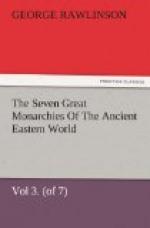The shape of Media has been called a square; but it is rather a long parallelogram, whose two principal sides face respectively the north-east and the south-west, while the ends or shorter sides front to the south-east and to the northwest. Its length in its greater direction is about 600 miles, and its width about 250 miles. It must thus contain nearly 150,000 square miles, an area considerably larger than that of Assyria and Chaldaea put together, and quite sufficient to constitute a state of the first class, even according to the ideas of modern Europe. It is nearly one-fifth more than the area of the British Islands, and half as much again as that of Prussia, or of peninsular Italy. It equals three fourths of France, or three fifths of Germany. It has, moreover, the great advantage of compactness, forming a single solid mass, with no straggling or outlying portions; and it is strongly defended on almost every side by natural barriers offering great difficulties to an invader.
In comparison with the countries which formed the seats of the two monarchies already described, the general character of the Median territory is undoubtedly one of sterility. The high table-land is everywhere intersected by rocky ranges, spurs from Zagros, which have a general direction from west to east, and separate the country into a number of parallel broad valleys, or long plains, opening out into the desert. The appearance of these ranges is almost everywhere bare, arid, and forbidding. Above, they present to the eye huge masses of gray rock piled one upon another; below, a slope of detritus, destitute of trees or shrubs, and only occasionally nourishing a dry and scanty herbage. The appearance of the plains is little superior; they are flat and without undulations, composed in general of gravel or hard clay, and rarely enlivened by any show of water; except for two months in the spring, they exhibit to the eye a uniform brown expanse, almost treeless, which impresses the traveller with a feeling of sadness and weariness. Even in Azerbijan, which is one of the least arid portions of the territory, vast tracks consist of open undulating downs, desolate and sterile, bearing only a coarse withered grass and a few stunted bushes.




